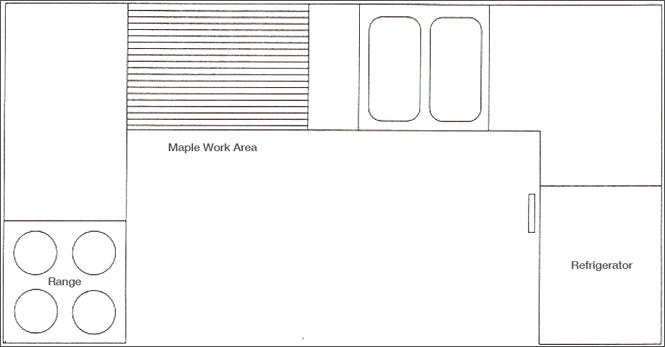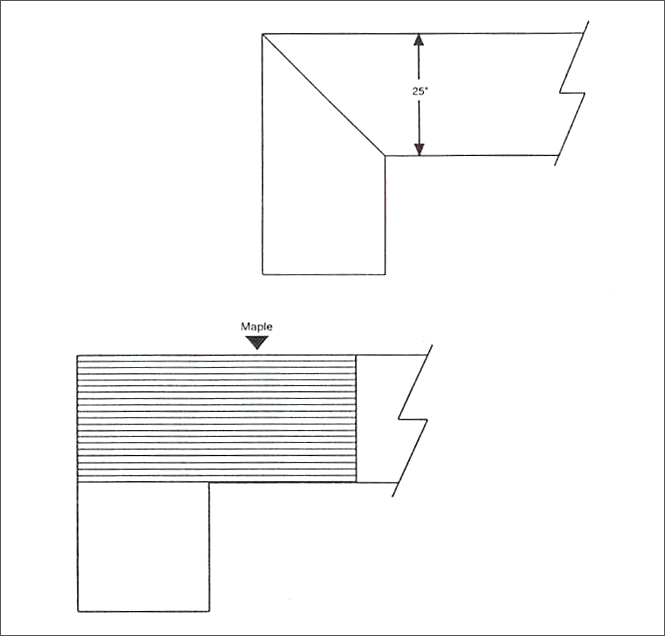For the best results in the installation of your butcher block surface, it is important to read and follow these instructions. Wood is a hygroscopic material, it continues to gain and lose moisture throughout its existence. Following these simple instructions will ensure that you get the best out of your butcher block for years to come.
Installation Tips
Congratulations on your selection of Wood Welded® Butcher Block. Great craftsmanship and care goes into the manufacturing of our butcher block surfaces. Its rich appearance, distinctive grain patterns and color variations are the purest expressions of nature. Man-made material cannot duplicate hardwood’s variety, natural integrity and authenticity. Please familiarize yourself with the following information prior to installation.
Finish
Butcher Block is intended to be used as a true cutting surface. Our countertops are coated with a crystal clear satin acrylic finish, DURAKRYL 102®, which requires little to no maintenance. It is not necessary to sand off the finish prior to installing the top, as this finish is approved for food service use. The finish is formulated to repel most household solvents. Stains can be cleaned off with finger nail polish remover or bleach—neither of these two substances can hurt the finish— and although the finish is durable, it will scratch.
Clean it like you would any cutting surface, not allowing water to stand on the surface for any length of time. If your top will be used as a cutting surface, periodically reseal ONLY the area in which you cut with mineral oil or Emmet’s Elixir Wood Conditioner. If it becomes necessary to refinish your top due to heavy usage, we suggest sanding off the finish and applying either an oil finish or resealing it with the “Good Stuff”® urethane gel clear protective finish.
Expansion and Contraction
Butcher Block contains 6% moisture content during factory fabrication and storage. Occasionally the block may take on additional moisture during transport, especially in spring and fall months. As a result, slight warpage may occur and the block may expand as much as 3/16” in width (the block will not change in length). The wider the block, the greater the expansion. This is temporary. Once the top has become adjusted to the new installation environment, the moisture content will equalize and the panel will straighten out.
Measure your block prior to installation to determine if it has changed in dimension. If so, allow the block to acclimate to the interior in which it will be installed. Under normal conditions the block will return to the original dimension during the winter months and will expand slightly during the summer months when the humidity is greater. In regions where winter temperatures drop to 15° or lower, indoor humidity can drop as low as 10% relative humidity. At that low relative humidity, a 25” block can shrink as much as 1/8”. Be sure to make allowances for this dimensional change.
Warping is caused by the expansion of either the top or bottom surface. This condition is easily corrected by placing the block on the cabinet bases and drawing the block down to a level position with wood screws. All countertop blocks should be attached to bases on or at least near all four corners.
If the top is too warped to fasten down, allow both sides of the block to be exposed. This temporary condition will be correct itself as the moisture content of the block is equalized on both the top and bottom surfaces. Where attaching the block to a cabinet base is not possible, attach one or more angle irons to the underside of the block. Use 3 screws to draw down to each angle iron. Be sure to allow for expansion and contraction.
Attaching the Counter Top
Do not set the counter top with adhesive caulk. Instead, securely fasten the top to the base unit using appropriate length wood screws. Most cabinet manufacturers provide corner blocks within the cabinet for attaching the countertop to the cabinet base. Pre-drill pilot holes through the corner blocks into the underside of the top. Be careful not to drill through the top.
Note: Do not mount a butcher block countertop directly to a solid-topped base unit without allowing a 1/16″ air space between the butcher block top and the solid-topped base.
Commonly, cabinet manufacturers build in full-coverage dust covers atop base cabinets. This qualifies as a solid-topped base, as does covering or mounting over an existing sub-surface of a different material.
Mounting a wood top directly to a solid-topped base restricts airflow to only the topside of the butcher block, resulting in stress build up within the block. By simply mounting the top with a gap to accommodate airflow, it will virtually eliminate the risk of cracking, delaminating and warping. To add a gap for proper airflow, place 4 washers, one in each corner, as spacers, before mounting the butcher block in place.
Some manufacturers of cabinets and appliances take into consideration expansion and contraction by providing slotted screw holes. Locate the screws in the center of the slots. Where a manufacturer has not made such allowances, use an undersized screw with a washer. A suggested way to make this allowance in attaching wood parts is to counter sink the pilot holes where the wood part attaches to block, or make the pilot holes oversized using a flat head screw and a washer.
If installing a back splash along with the countertop, attach it to the surface, not to the back edge that would be against the wall.
Post-form countertops are popular. Butcher Block does not come in this shape, however many installers will use a hand router to round the front edge of the block to conform to the front edge of the post-form top. When this cut is made, sand smooth and finish with the “Good Stuff”, a clear protective urethane gel that’s compatible with our factory finish.
Cut-outs and Cut-offs
If a butcher block top requires cutting for proper installation—either for a size adjustment or for a sink or cook top cutout—the cut edges need to be refinished immediately to prevent potential cracking along the glue lines.
Use either a lacquer or a clear satin polyurethane finish. Do not use oil only, as it will not provide a permanent seal. We suggest resealing the cut edge with our finish, the “Good Stuff”, or a satin polyurethane or lacquer finish.
For cook top cutouts, applying an aluminum heat reflective tape with attached insulation after the edge has been refinished will dissipate heat into the cabinet below. This will allow the top to expand and contract more evenly. We recommend M-D Insulated Foam “Pipe Wrap” (Item # 02378) which can be purchased at many building centers.
Michigan Maple Block Co. or Bally Block Co. are not responsible for tops that have been cut, altered or reworked in any fashion.
Save Money in the Corners
Turning the corner with a 4-foot block saves 25” of cabinet top that is cut away for the miter. Separate pieces are easier to install and any variations in this corner angle can be compensated for on the job.
On the other hand, although more expensive, a well fit miter joint is a handsome installation detail. Please note: in a corner miter installation, the lamination within the butcher block will not align because the wood staves that make-up each block are of random width.
Split Ends

This condition is caused by the contraction of the butt ends and not that of the center part of the block. These cracks can occur on the glue line where the wood is the weakest or in the lamination itself. This is often a result of the environment being too dry or because the block was not properly resealed if cut/altered during installation (see section “Cutouts and Cutoffs”). To remedy the condition, measure and adjust the relative humidity accordingly. The cracks should be filled promptly with wood filler, sanded smooth, and finished with the “Good Stuff” Urethane Gel clear protective finish.
Placement / Layout
Most cooks prefer an area between the cooking surface and the sink for the butcher block work area. The size of the work area is a matter of personal choice. When properly located, the butcher block will receive all the knife marks and hot pots that can typically blister laminate surface.



